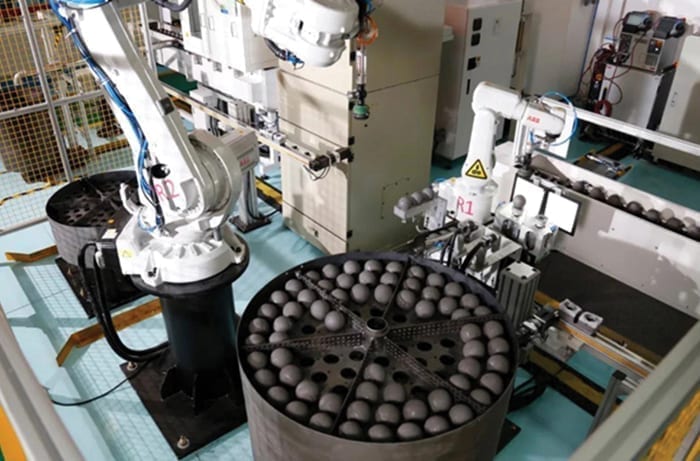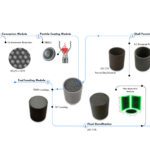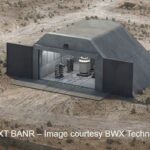Tristructural isotropic (TRISO) particle fuel has long been used in high-temperature gas-cooled nuclear reactors, but it is seeing a resurgence as a result of other applications. Modern TRISO fuel designs are under consideration for an assortment of advanced reactors, including high-temperature reactors and microreactors, and even as accident-tolerant fuel for light water reactors.
In October 2020, when the U.S. Department of Energy (DOE) announced it chose TerraPower and X-energy to each receive $80 million in initial federal funding under the agency’s Advanced Reactor Demonstration Program (ARDP) to build their two distinct advanced nuclear reactors and begin operating them within seven years, the advanced reactor community was abuzz about the agency’s larger scope for X-energy. Under the award, Rockville, Maryland–based X-energy will deliver a commercial four-unit power plant (likely in Washington state) based on its Xe-100 reactor design—an 80-MWe/200-MWth pebble-bed high-temperature gas-cooled reactor (HTGR). But X-energy will also leverage the award to deliver a commercial-scale fuel fabrication facility for its proprietary TRISO-X TRi-structural ISOtropic (TRISO) particle fuel, technology it developed under the 2015 DOE Advanced Gas Reactor (AGR) Fuel Qualification Program. As some industry observers noted, the award re-establishes a longstanding commitment by the DOE to render the U.S. into a technology purveyor of the specialized nuclear fuel form that is expected to quickly gain traction around the world as new advanced reactor designs emerge on the global power scene.
TRISO Is Complex, but Not Complicated
As the DOE explained to POWER in February, TRISO is essentially a “robust, microencapsulated fuel form” developed originally for use in HTGRs in the 1950s. Modern “particles”—which can be “about the size of a poppy seed”—typically consist of a spherical fissile “kernel” sheathed by several layers of pyrocarbon (PyC) and a silicon carbide (SiC) layer. These particles can then be packed together into different forms, most prominently cylindrical pellets or billiard ball–sized spherical fuel forms, called “pebbles,” using a resinated graphite matrix material (Figure 1).
 |
|
1. This U.S. Department of Energy (DOE) graphic shows different TRi-structural ISOtropic (TRISO) particle fuel forms. On the right is a micrograph of a coated particle with exposed kernel and coating layers. Also shown are examples of spherical (pebble) and cylindrical (compact) fuel forms, and prismatic graphite blocks. Source: DOE |
Perhaps TRISO’s biggest benefit is that each particle acts “as its own containment system thanks to its triple-coated layers,” the DOE explained. “This allows them to retain fission products under all reactor conditions.” TRISO particles are also especially robust. “TRISO fuels are structurally more resistant to neutron irradiation, corrosion, oxidation, and high temperatures (the factors that most impact fuel performance) than traditional reactor fuels,” the agency said. And most importantly, they are safe. “Simply put, TRISO particles cannot melt in a reactor and can withstand extreme temperatures that are well beyond the threshold of current nuclear fuels,” it said.
While several exotic kernel compositions and different matrix materials have been proposed to date, so far, the DOE’s TRISO fuel qualification efforts have focused on what it calls “conventional” TRISO particles. These have a kernel composed of a mixture of uranium carbide and uranium oxide, which the industry colloquially refers to “as uranium oxycarbide” (UCO).
“When the uranium in a uranium dioxide (UO 2) molecule splits, the oxygen ions released can react with carbon in the pyrolytic layers to form carbon monoxide (CO) gas,” the DOE said. “At very high burnup, the accumulated CO gas may exert excessive pressure on the particle coatings and cause them to fail. The UCO mixture limits the amount of free oxygen released from the kernel, enabling higher burnups to be achieved, as has been confirmed during post-irradiation examination of TRISO fuel,” it said.
Because TRISO enables a high temperature output in advanced reactor designs, it could potentially boost the use of nuclear energy beyond electricity generation into energy sectors, for example, that are currently dominated by fossil fuels such as process heat, oil shale and sand reprocessing, petroleum refining, desalination, and hydrogen production. Meanwhile, owing to TRISO’s fuel form flexibility, and despite its origin and historic use in HTGRs, the conventional particle design could be well-suited to several types of advanced, high-temperature reactors (HTRs), including the fluoride salt–cooled HTRs, and microreactors. More exotic compositions (that still retain the fundamental TRISO coating structure) are also being considered as accident-tolerant fuel for light water reactors.
A 50-Year Developmental Legacy
The modern TRISO particle has evolved through a series of improvements in particle design, coating layer properties, and kernel composition. According to the DOE, the concept of nuclear fuel microspheres with refractory coatings to contain fission products can be traced to the early years of the nuclear age, when they were developed for the 20-MWth Dragon reactor, a prismatic-core HTGR that achieved critically in the UK in 1964. “The first fuel charge included fissile particles consisting of several consecutive layers of pyrocarbon with different properties, and fertile particles with both PyC and SiC coating layers formed into annular cylinders,” the DOE noted.
Peach Bottom 1, an experimental 115-MWth prismatic HTGR in York County, Pennsylvania, that reached criticality in 1966, used pyrocarbon-only coated particles. However, that reactor “also contained fuel test elements in which a large number of different types of particles were irradiated, including TRISO particles with various kernel types, and post-irradiation examination of these elements yielded a large amount of data on fuel performance,” the DOE said. Other reactors that bolstered TRISO research and development include the 1967-completed 46-MWth Arbeitsgemeinschaft Versuchsreaktor (AVR) unit in Germany—the first “pebble-bed” reactor design. AVR initially used the two-layered bi-structural isotropic (BISO) particle design before adopting TRISO as a standard fuel for the remainder of its operational years, which ended in the late 1980s.
During the 1970s, TRISO coatings grew more sophisticated, gaining from advances in fabrication technology, SiC and pyrocarbon coating properties, coated particle irradiation performance, fuel performance modeling, and fission product release observations. The robustness of these new fuel forms was put to test at the Fort Saint Vrain HTGR in Colorado, which operated between 1976 and 1989.
 |
|
2. Fuel loading at the Shidaowan high-temperature gas-cooled reactor pebble-bed module (HTR-PM) in China, slated to begin in April 2021, will involve putting 870,000 spherical TRISO fuel elements into the two small reactors that will drive a single 210-MWe turbine. Courtesy: China National Nuclear Corp. (CNNC) |
HTGR fuel development has since burgeoned in Germany, China, Japan, South Africa, France, Russia, and South Korea. China, notably, has made remarkable progress to develop TRISO-coated particle fuel for its Shidaowan HTGR pebble-bed module (HTR-PM), a Generation IV reactor. Fuel loading (Figure 2) at that project is expected to begin this April.
Bolstering Commercial TRISO Development
Several high-temperature reactor developers have leveraged data from DOE-supported AGR TRISO fuel experiments. In tandem, the DOE has been working to establish a pilot-scale TRISO fuel manufacturing capability in the U.S. Initially, the fabrication process was a joint activity between the Idaho National Laboratory (INL), Oak Ridge National Laboratory (ORNL), and an industrial fuel vendor, BWX Technologies (BWXT).
BWXT told POWER it worked with the DOE for more than 15 years under the AGR program to develop and manufacture TRISO-coated kernels at its specialty fuel facility in Lynchburg, Virginia, to support the government’s vision of developing “passively safe, compact nuclear reactors capable of economically generating electricity and hydrogen” before it ceased TRISO production in the spring of 2017. Last November, however, the company said its Nuclear Operations Group had completed its TRISO nuclear fuel line restart project, which means the company’s Lynchburg, Virginia, facility is now actively producing the fuel again. BWXT said restarting its existing TRISO fuel production capability and increasing its capacity would position the company to meet emergent client interests in Department of Defense microreactors, space reactors, and civil advanced reactors. “By co-locating the TRISO production line with other existing uranium processing capabilities, BWXT has a vertically integrated facility capable of handling all TRISO-related needs from feedstock preparation through uranium recovery and purification,” it said.
X-energy, Kairos, USNC Making Crucial Progress
The DOE is also working with Kairos Power, developer of a fluoride salt–cooled high-temperature reactor (FHR). Similar to a molten salt reactor, FHRs use solid TRISO fuel instead of liquid fuel dissolved in the coolant. “[Kairos’s] design would use TRISO fuel in a pebble form with a fluoride-lithium-beryllium (FLiBe) salt coolant to allow high temperature output by the FHR,” the DOE said. “In addition, the previous extensive DOE TRISO fuel qualification studies … would shorten the timeline to demonstrate this reactor type.” The DOE has backed the development of the Kairos design through an assortment of funding opportunities, including via Gateway for Accelerated Innovation in Nuclear (GAIN) vouchers and other industry partnership awards, it noted.
X-energy, too, has long had the DOE’s backing. X-energy’s TRISO-X fuel pebbles, which build off the AGR experiments, comprise pebbles that contain thousands of specially coated TRISO fuel particles. These particles “seal uranium particles in a protective coating, are virtually indestructible, retain the waste inside, and make meltdown impossible while releasing no carbon emissions. The entire process releases even less carbon than wind or solar,” the DOE said. The inherent safety of the design would allow a fabrication facility to be constructed within 500 meters of factories or urban areas, it suggested.
For now, X-energy continues to run a TRISO-X fuel fabrication pilot line at the ORNL Uranium Building, co-located within the ORNL AGR TRISO Fuel laboratory area. The TRISO-X pilot line reportedly has full production size (engineering-scale) fabrication equipment to make UCO kernels, coat them with a buffer layer, two PyC layers, and the SiC layer that acts as a fission product containment barrier for the fuel. The same pilot line production equipment could be used in X-energy’s commercial TRISO-X fuel fabrication facility that the DOE is funding under the ARDP program.
Ultra Safe Nuclear Corp. (USNC), another notable TRISO fuel developer, is spearheading development of its proprietary Fully Ceramic Microencapsulated (FCM) fuel, which consists of coated nuclear fuel particles embedded inside a dense and fully sealed SiC matrix. “The specific coated fuel particles are TRISO microspheres that provide micro-encapsulation of the fuel with multiple pyrocarbon and a SiC coating layer,” USNC CEO Francesco Venneri explained to POWER. “Using FCM technology, an additional layer of protection against radionuclide release is added by taking advantage of SiC as the matrix for these coated fuel particles. This macro-encapsulation further enhances radionuclide retention capability of the fuel, and allows for design and deployment of ultra-safe nuclear energy systems.”
USNC, notably, in September opened a new facility in Salt Lake City, Utah, to support the development of its FCM fuel and materials that will be used in its own Micro-Modular Reactors (MMR), as well as other nuclear reactors, including gas-cooled reactors, light water reactors, CANDU reactors, and molten salt–cooled reactors.
—Sonal Patel is a POWER senior associate editor.










